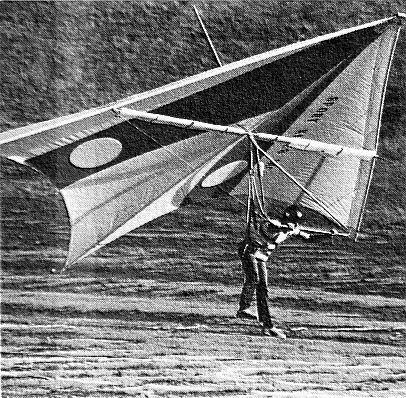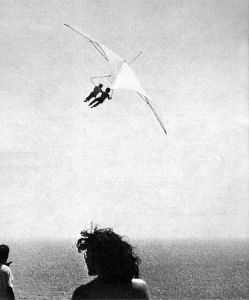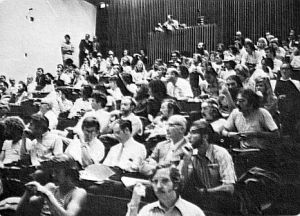Home (contents) → Hang gliding → Hang gliding 1974 part 2
Hang gliding 1974 part 2
This page continues from Hang gliding 1974 part 1.
The images here are artistic derivations of contemporary photos. See Copyright of early hang gliding photos.
I am convinced that if there is a truly inspired race upon the face of the earth, it must be the hang glider pilots.
— Carol Boenish-Price, USHGA magazine Ground Skimmer, May 1975


Even those who did not fly wanted to be part of this social revolution. This is from a description of a meeting of the Southern California Hang Glider Association, soon to metamorphose into the USHGA:
The first speaker was a youth in glasses who must have been from Cal Tech because he drew formulas and equations on a blackboard, mumbling abstractly and mostly inaudibly until everyone began stirring.
— Maralys Wills and Chris Wills, Higher than Eagles, the Tragedy and Triumph of an American Family, 1992 (see this site’s review of the book)
In Britain during the winter of 1973-4, weekend motocross racer Brian Wood went to a local bookstore (WH Smith) to look at aviation books to discover something about hang gliding. One book gave the address of the National Hang Gliding Association, which happened to be only ten minutes drive from Brian. Moreover, the Wasp hang glider factory was only 20 minutes away.
On Brian’s third weekend flying, during Easter 1974 at Truleigh Hill (at the end of the Devil’s Dyke ridge on the Sussex Downs) he saw Wasp test pilot John James Haynes encounter lift in an experimental wing (the first CB 240)… (1)
John clipped into the new glider and made an easy take off. However instead of starting the gentle downward glide he flew straight out. It looked good, but within seconds I could see the right-hand side wire hanging down from the control bar! The right-hand cross tube started to bend up, then snapped. The glider folded up like butterfly wings and down it went.
What helped to save John’s life was that he hadn’t flown too fr away from the take-off. He had come straight down, possibly 300ft, but where he had landed was still on the slope of the hill. He had terrible injuries and many broken bones, but was still breathing. Unbelievable!
— Brian Wood (6)

The cable had been clamped over the plastic coating. A week before the accident, pioneer pilot Nick Regan had tested the clamp, which was designed to be used on plastic coated cable, to failure at 260 lb.
…we both decided that the loads imposed on a Rogallo wing’s flying wires would not approach this figure. We were both WRONG.
— Nick Regan (2)
For more of Nick Regan, see Rogallo versus Quicksilver in colour in Hang gliding 1974 part 3 and see South Downs in Hang gliding early 1980s part 1.

Despite witnessing that accident, Brian Wood continued flying. At the first British championships, held at Steyning bowl on the Sussex Downs in July 1974, Brian was the only individual who the organizer knew who he could trust to take the car park money, but “I’ll call you when it’s your slot to fly.” From the car park Brian was unable to see his fellow competitors’ flights.
This went on the whole weekend: car park attendant … flyer … car park attendant … flyer.
— Brian Wood, SkyWings (BHPA magazine) June 2021
After the flying was over, the organizers calculated the scores and final positions, while Brian and his wife put his glider and gear back on their Volkswagen camper van.

I thought they were joking and it was just a wind-up, but no! I walked over to the marshalls’ tent to see the scores myself, and yes, I had scored the most points. Unbelievable!
Brian the car park attendant became the first British hang gliding champion.
Later that year Brian attempted to beat the flight duration record set by Bob Wills in Hawaii. Bob had by then improved on his eight hour record with a flight of more than 10 hours. On October 5th 1974 Brian flew at an informal gathering organized by Steve Hunt of Hiway Hang Gliders, Brighton, Sussex. The chosen site was Rhossili, a high rounded hill overlooking a huge beach in south Wales. At its southern end are low cliffs leading straight down to the ocean. Brian flew a Wasp 229 B3 standard Rogallo with a webbing upright harness. The wind, which peaked at 38 mph between showers, veered and Brian moved over to the cliffs. He was then astonished to find himself soaring motionless over a flat beach in perfectly smooth air. After a trial run by Eric Short, Tony Beresford succeeded in flying above Brian and supplying him with hot food and drink dangling on a line. When Brian landed back on top of the main ridge, his legs were numb (a known problem of that type of harness) and when he touched down he put the nose down into wind and sat there for a while to let his circulation resume. He did not match Bob Wills’ record, but he set a British record of more than eight hours. (3, 4)
See also Harnesses.
During Brian’s long flight, there were three crashes of other hang gliders. The most serious was that of Brian Gaskin. After two hours in the air, he was blown back over the cliff top and into the rotor, crashed and sustained an ‘impacted spine.’ He was in hospital for a while, but resumed flying about two months later. (5)
Hawaiian Ed Cesar and Londoner Brian Wood were flying friends and competed in far-away places such as Norway.

Ed Cesar became a test pilot for Los Angeles-based Eipper-Formance. Outside the hang gliding world, Ed subsequently ran a business creating aircraft interiors and his clients included the actor and jet pilot John Travolta. Coincidentally, Brian also worked in airliner refurbishment.
For a spectacular photo of Ed Cesar, rather than a photo by him, see under Antares, Ten Meter, and others in Hang gliding 1978 and 1979 part 3. See also the Brian Wood related topics menu.

That looks to me like the Scripps Institution of Oceanography pier, which is at the south end of the Torrey Pines ridge, San Diego.
Kent Trimble, Lee Wilson, and Alan Dimen founded Manta Products of Oakland, San Francisco, in November 1972. As far as this author has determined, only three other Rogallo flex-wing hang glider manufacturers existed at the time, two in California; Bill Bennett’s Delta Wing and Dick Eipper’s Eipper-Formance, both in the Los Angeles area; and Moyes Delta Gliders in Australia. Manta claims to be first to introduce the foldable control frame and no-tools set-up. (Source: Whole Air January-February 1983)
See the Manta Products of California related topics menu.


Rich Grigsby was a founding partner of Sunbird Ultralight Gliders, based in Canoga Park, California. He took over from Carol Price as editor of Ground Skimmer.
Swallowtail
Despite the performance advantages of the rigid wing hang gliders, the simplicity, portability, and ruggedness of the Rogallo ensured its popularity.

Could its performance be improved without sacrificing its advantages? The Wills brothers and Chris Price took the 90-degree nose angle standard Rogallo with reduced billow and cut a ‘helical’ curve into the trailing edge. They called the resulting design the Swallowtail.

The leading edges of Chris Price’s prototype were each four feet longer than the keel, restoring the sail area, but resulting in a lanky look reminiscent of the Windlord 4, Cirrus, and other contemporary short-keel Rogallos. However, early production Swallowtails were made in several variants, some with equal length leading edges and keel, and some with longer leading edges.
They subsequently added a small amount of ‘roach’ at the wing tips, each supported by a short radial batten. (By radial, I mean each batten was aligned towards the nose. It was therefore straight and it rolled up with the sail for transporting.)


The Swallowtail was the first glider I owned that flew really well. It was the first properly balanced and well-tuned wing that I ever flew that enabled me to experience anything approximating trim. It was a revelation and showed me what real control was like.
— Ken de Russy (e-mail correspondence, February 2020). For more of Ken de Russy, see the Santa Barbara Hang Glider Emporium page.

Sport Kites manufactured 270 Wills Wing Swallowtails. See Wills Wing glider production history.
There are some color photos that include Swallowtails on the next page. See also the Sport Kites/Wills Wing of California related topics menu.

Following the Northrop Institute of Technology Ultralight Flight Seminar in January 1974 (see Hang gliding 1974 part 1) the AIAA/SSA/MIT International Symposium on the Technology of Low Speed and Motorless Flight was held in September. There, a presentation explained how the Icarus V wing shape was determined by computer.
See also the Computing in hang gliding related topics menu.
This topic continues in Hang gliding 1974 part 3.
External links
Chelan – The Early Years unusually high quality film taken at the Washington State site, on Jack Olson’s YouTube channel
Sources and references
1. Conversations with Brian Wood in person and over telephone, including on Sunday 10 May 2020
2. Report by Nick Regan in NHGA magazine The Illustrated Monthly Flypaper, November 1974
3: Brian Wood verbal account to this author and others at the home of Roly Lewis-Evans on October 28th 2021
4. You Can’t keep Him Down by Terry Haynes, Illustrated Monthly Flypaper, October 1974 on British Hang Gliding History
5. Brian Gaskin interview in the documentary RR7513B AUSTRIA WORLD HANG-GLIDING CHAMPIONSHIP on the AP Archive YouTube channel, starting at 4 minutes 1 second
6. Attention all pilots by Brian Wood, SkyWings (BHPA magazine) March 2021